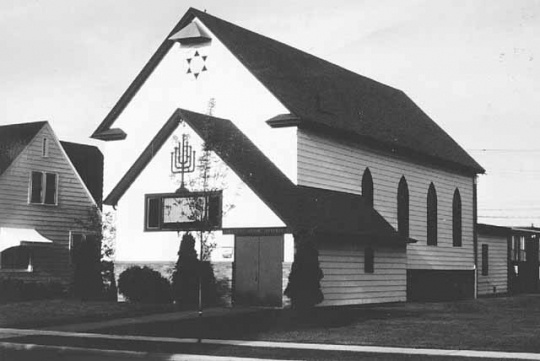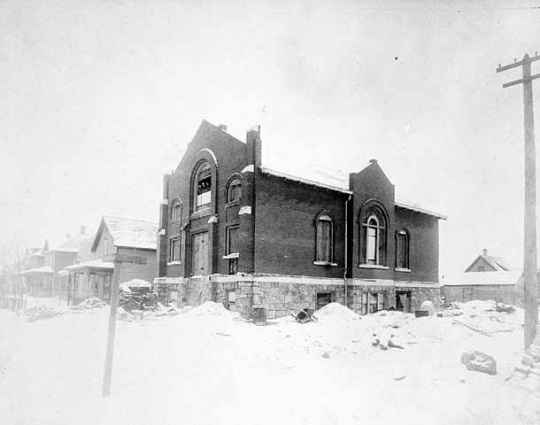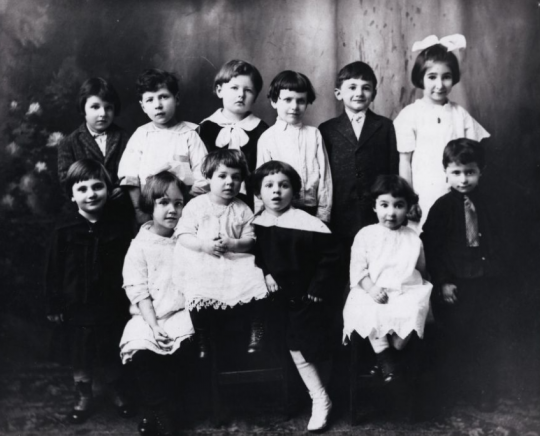In the late nineteenth century, some of the Jewish immigrants who had originally settled in the Twin Ports of Duluth-Superior saw economic opportunity in the nearby Iron Range of northern Minnesota. From the 1890s through the 1920s they founded retail and service businesses in the region's booming mining towns. Though small in numbers and relatively isolated, Iron Range Jews supported a vibrant communal life through the 1980s, when hard times on the Range led to a general depopulation.
Jews first settled on the Iron Range in the Vermilion area in the early 1890s. By 1907, forty Jews could be found in Hibbing, eighteen in Virginia, and fourteen each in Eveleth and Chisholm. Smaller Iron Range towns also had Jewish residents.
Just three years later, in 1910, the number of Jews on the Iron Range increased to about eight hundred individuals living in twelve towns. The majority, 70 percent, earned their living in retail trades and services. These Jewish shopkeepers and their families were accepted middle-class members of their communities. They experienced little anti-Semitism in contrast to Jews in larger cities, including Minneapolis. The Iron Range's Jewish population peaked in 1920, with 1,112 Jews living in eighteen Range towns. In 1927, at least 824 Jews lived in the four largest towns.
Many of the Jews who settled in Duluth-Superior and on the Iron Range had emigrated from Lithuania. Nearly all were related or were landsleit (from the same town or region). The practice of Orthodox Judaism was a key bond among them.
Synagogues were founded in the four largest Iron Range towns in the opening decades of the century. Agudath Achim (Fellowship of Brothers) in Eveleth was founded in 1900. It was followed by Agudas Achim in Hibbing, founded in 1904. Both congregations met in converted church buildings. B'nai Abraham in Virginia, founded in 1905, built its own synagogue, as did B'nai Zion in Chisholm, founded in 1913. Most Iron Range Jews were associated with one of these synagogues. In Virginia, for instance, records suggest that approximately 80 percent of the city's Jews belonged to B'nai Abraham. This figure had risen to 90 percent by the 1950s.
The Iron Range's remote location and the small size of its congregations made it difficult to attract and retain competent rabbis and cantors. The 1910 federal census did list a rabbi in Eveleth, a "Jewish minister" in Hibbing, and two "Jewish priests" in Chisholm. In 1920, two Russian immigrant rabbis were hired in Hibbing and Virginia.
The religious life of Iron Range Jews, however, depended on lay leadership to a greater extent than in larger cities. At various times, each of the four largest Iron Range towns hired kosher butchers and trained Hebrew School teachers. For example, in 1917 Eveleth held Sunday Bible class and weekday instruction in Hebrew. Hebrew instruction in Virginia was overseen by a lay board of education. In 1937, the Hibbing congregation sponsored a Sunday religious school with an enrollment of sixty children and a teaching staff of six.
Orthodox religious practice remained strong on the Iron Range into the 1940s and beyond. The Eveleth and Virginia communities had kosher butchers into the 1950s. The immigrants in Chisholm, who were known as the most religious on the Iron Range, even supported a mikvah (ritual bathhouse) and a kosher meat market as late as 1956. Chester Proshan, a scholar of Iron Range Jewry, has written that "religious fervor" may have persisted there more than in larger cities in part because many of those in the close-knit community came from Vilna (today, Vilnius). The Lithuanian city was a leading Jewish spiritual and intellectual center before World War II.
When strict religious observance collided with the need to make a living, pragmatism prevailed. Friday night and Saturday morning, the Jewish Sabbath, were prime shopping times in Iron Range market towns. Small businesses owners would attend services, then open their stores. The High Holidays—Rosh Hashanah and Yom Kippur, during which stores remained closed—were the exception.
Many of the descendants of the original settlers stayed on the Range, raising their children and working in family businesses. Immediately following World War II, the Iron Range's Jewish population was about 750 to 800 people. In 1948, 120 Jews could be found in Eveleth, 268 in Hibbing, 164 in Virginia, and fewer than one hundred in Chisholm.
While the second generation was less stringent in their religious practice, traditional rituals did persist. In Hibbing, separate seating for men and women in the synagogue was maintained as late as 1958. The Eveleth and Virginia congregations arranged with an Orthodox rabbinical school in Chicago to hire a rabbi for the High Holidays until the 1950s.
For the baby-boom generation, the lure of careers and life in larger cities was strong. The Iron Range's Jewish population continued to decline. B'nai Zion in Chisholm, the smallest community, closed in the 1960s. The synagogue building was demolished. The Eveleth synagogue closed in 1970. Its building once again housed a church. The Hibbing and Virginia synagogues took in members from the disbanded congregations.
In 1973 the Virginia synagogue allowed women to be counted in the minyan, the minimum of ten men required for worship in Orthodox practice. Jewish children from the Range were sent to Hebrew school in Duluth when their own Hebrew schools closed.
During the 1970s and 1980s, the Iron Range experienced severe economic decline. Six thousand residents and ten thousand jobs were lost in northeast Minnesota between 1980 and 1985. This had a profound effect on Jewish-owned retail businesses. By the end of the 1980s, fewer than two hundred Jews lived on the Range.
Agudas Achim, the Hibbing synagogue where Bob (Dylan) Zimmerman had his bar mitzvah, closed in the mid-1980s. B'nai Abraham in Virginia was the last to close, in the mid-1990s. The brick building was listed on the National Register of Historic Places in 1980, the only synagogue in Minnesota to be so honored. Friends of B'nai Abraham, a nonprofit group made up of former members, their descendants, and other Iron Range residents, purchased the building in 2004. It reopened in 2008 as the B'nai Abraham Museum and Cultural Center.







